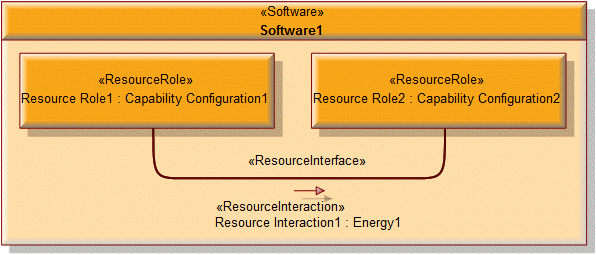SV-6 Systems data exchange matrix (UPDM - MODAF aliases)

Creation
To create an SV-6 Systems Data Exchange Matrix:
• Right-click the
Architectural Description or
Service Description that is to own the SV-6 Systems Data Exchange Matrix, point to New, point to Matrix/Table, point to MODAF, and then click SV-6 Systems Data Exchange Matrix.
• Right-click the
Capability Configuration,
Organization,
Post,
Physical Architecture,
Role Type,
Resource Artifact,
Service Access or
Software that is to own the SV-6 Systems Data Exchange Matrix, point to New, point to MODAF, and then click SV-6 Systems Data Exchange Matrix.
When you open an SV-6 Systems Data Exchange Matrix, Modeler can generate it as HTML for viewing in your Internet browser, or generate it as a spreadsheet for viewing in Microsoft Excel. To specify how matrices and tables are opened for a model: in the Packages pane, right-click the Model, point to > > , and then select HyperTextMarkupLanguage_HTML or Excel_XLS.
Each time you open an SV-6 Systems Data Exchange Matrix, Modeler generates the product using the latest data from the model.
Purpose
On an SV-6 Systems Data Exchange Matrix:
• View
Resource Interaction elements from the analyzed Packages in a table.
• View the conveyed classifier of each Resource Interaction.
• View
Actual Property Set elements that have been applied to the shown Resource Interaction elements.
• View
Capability Configuration,
Organization,
Physical Architecture,
Post,
Resource Artifact,
Role Type,
Service Access and
Software elements that produce and consume each Resource Interaction.
Elements Shown
An SV-6 Systems Data Exchange Matrix shows the following elements.
• A row is created for each
Resource Interaction element that produces or consumes a Capability Configuration, Organization, Physical Architecture, Post, Resource Artifact, Role Type, Service Access and Software that is found in the analyzed Packages.
• The table shows the Name of each Resource Interaction element's conveyed classifier in the Conveyed Classifier column.

• The table shows the Name, Date Range and Intention of each Actual Property Set that is applied to a shown Resource Interaction.

Note that when a date has not been set, [...] is shown.
• The table shows the names of the
Capability Configuration,
Organization,
Physical Architecture,
Post,
Resource Artifact,
Role Type,
Service Access and
Software elements that produce and consume each Resource Interaction.
The table shows the
Resource Connector and
Resource Interface elements that realize each Resource Interaction.

• The table can also show measurements that apply to the Actual Property Sets.
To show or hide measurements: right-click the SV-6 Systems Data Exchange Matrix, point to Set, and then click Show Measurements.
Analyzed Packages
For a Capability Configuration, Organization, Post, Physical Architecture, Role Type, Resource Artifact, Service Access or Software owned SV-6 Systems Data Exchange Matrix, the Analyzed Packages are ignored and only the owning element is used to find Resource Interaction elements.
For an Architectural Description or Service Description owned SV-6 Systems Data Exchange Matrix, by default the OV-3 Operational Information Exchange Matrix searches for Resource Interaction elements that produce or consume elements that are contained within the Architectural Description or Service Description that owns the SV-6 Systems Data Exchange Matrix.
To search for elements from other Architectural Description and Service Description packages:
• Right-click the SV-6 Systems Data Exchange Matrix, point to Links, and then click Analyzed Packages. From the Links Editor, select the Architectural Description and Service Description packages from which you want to search for elements.
Example
In this example, the Architectural Description that owns SV-6 Systems Data Exchange Matrix1 contains Software1. Software1 owns SV-1 Resource Interaction Specification1 that defines two Resource Role elements that use that Capability Configuration1 and Capability Configuration2 as their types. A Resource Interface links the two Resource Role elements and Resource Interaction1 is realized by that Resource Interface. Resource Interaction1 uses Energy1 as its conveyed classifier.

We create Actual Property Set1 and set its start date to 2015-01-01 and its end date to 2016-01-01, and then apply Actual Property Set1 to Resource Interaction1. To do this we right-click Resource Interaction1, point to Links, and then click Actual Property Set.
We create Function1. Function1 owns an SV-4 Functionality Description that defines two Function Action elements that use Function2 and Function3 as their types. We create a Function Edge (Control Flow) between the two Function Action elements.

We want Resource Interaction1 to be realized by Function Edge (Control Flow), so we drag Energy1 (the conveyed classifier of Resource Interaction1) to the Function Edge (Control Flow). From the Select Resource Interaction dialog, we select Resource Interaction1.

We now generate SV-6 Systems Data Exchange Matrix1.
 from the generated table you can see the following.
from the generated table you can see the following.• A row has been created for each Resource Interaction that produces or consumes elements that are found in the analyzed Packages, that is, Resource Interaction1.
• The Resource Interaction1 element's conveyed classifier is Energy1.
• Actual Property Set1 has been applied to Resource Interaction1, the date range of Actual Property Set1 is 2015-01-01 to 2016-01-01, and its intent is Estimate.
• Capability Configuration1 and Function2 produce Resource Interaction1, and Capability Configuration2 and Function3 consume Resource Interaction1.
• Resource Interaction1 is realized by Resource Interface.
Note that the Protocol column is used only for Resource Connector elements, where the Protocol is implemented by the Resource Connector.
The following sections provide information about how an SV-6 Systems Data Exchange Matrix is used in the model.
Create an SV-6 Systems Data Exchange Matrix from
Creates or shows these UPDM elements



















